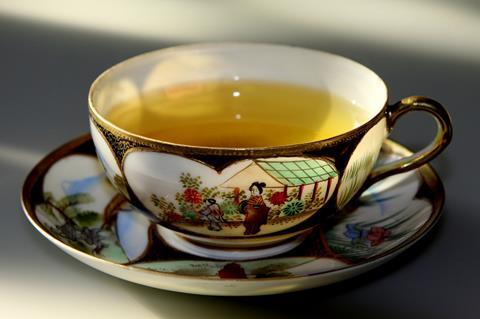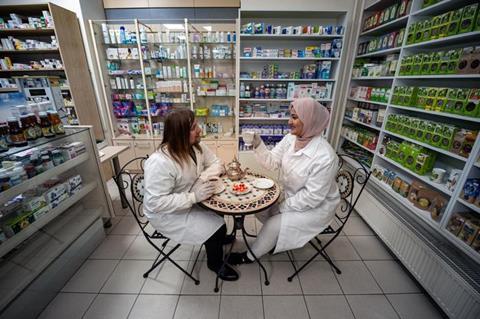Researchers at the Institute of Physical Chemistry of the Polish Academy of Sciences (IPC PAS) have demonstrated green tea-silver nanoparticles as a powerful tool against pathogens such as bacteria and yeast.

The team worked under the supervision of Prof. Jan Paczesny, who proposed new nanoformulations for use against widespread and challenging pathogens such as ESKAPE bacteria (Enterococcus faecium, Staphylococcus aureus, Klebsiella pneumoniae, Acinetobacter baumannii, Pseudomonas aeruginosa and Enterobacter spp.) and other problematic yeast pathogens such as Candida auris or Cryptococcus neoformans.
These microorganisms, treated with commercially available antibiotics, rapidly develop antibiotic resistance. Researchers chose ESKAPE as the target group since these pathogens lead to serious diseases, from sepsis even to cancer.
Silver and tea
A few months ago, Paczesny’s team decided to try combining silver nanoparticles, which are known for their antimicrobial and antifungal properties, and tea extracts which are rich in polyphenols additionally possessing antioxidant properties. The concept was to enhance broad-spectrum efficacy against pathogens using green hybrid silver nanoparticles (AgNPs), which are significantly more effective than all ingredients and even more effective than certain antibiotics.
In their work, three well-known tea varieties: black tea (B-Tea), green tea (G-Tea) and Pu-erh tea (R-Tea) were used as a capping agent, which acts as a stabilizer to protect the synthesized particles from aggregation. In this way, the particles offer a high active surface area compared to other formulations.
This synthesis is eco-friendly for the use of natural ingredients during precipitation. The structures produced vary in shape and size from 34 to 65 nm, depending on the type of tea used during synthesis, and show different reactivity towards microorganisms.
ESKAPE pathogens
Initially, silver nanoparticles produced in the presence of tea extracts (B-TeaNPs, G-TeaNPs and R-TeaNPs) were used to treat Gram-negative (E. coli) and Gram-positive (E. faecium) bacterial strains to test the effect on strains with different cell envelope morphologies. They looked at the interactions between the manufactured nanoparticles and the pathogens to determine efficacy, comparing the results with commercially available antibiotics.
The ESKAPE pathogens were then tested according to a protocol for the most effective concentration and composition of the particles, revealing up to a 25% decrease in the number of bacterial cells in E. faecium and a 90% decrease in the case of E. cloacae. Interestingly, the green silver nanoparticles also showed antifungal activity, leading to an 80% decrease in the number of viable cells of C. auris and about a 90% decrease for C. neoformans.

The first author, Sada Raza said: “What is more, the size of nanoparticles is usually related to the cytotoxic effect of nanomaterials, with smaller particles being more cytotoxic. This should favor control AgNPs and R-TeaNPs over G-TeaNPs and B-TeaNPs in our experiments.
”This was not the case. In most experiments, C-AgNPs and R-TeaNPs showed the lowest antimicrobial efficacy. This is in line with other studies, which demonstrated that size is not a primary factor affecting the antimicrobial activity of AgNPs.”
Phenolic compounds
The antibacterial and antifungal properties of silver nanoparticles made with tea extracts are greater than those of silver nanoparticles alone due to their high content of phenolic compounds, isoflavonoids (especially catechins such as epigallocatechin (EGC) and epigallocatechin gallate (EGCG)).
These combinations, using biologically active tea extracts and smaller amounts of silver nanoparticles, appear to be a potential way to combat a range of infections and even replace antibiotics in some applications.
The researchers found that the antimicrobial hybrid nanoparticles resulted in a significant reduction in bacteria compared to antibiotics or compounds separately. Although not all bacteria were killed, this is a significant improvement that could aid the treatment of superbugs using much lower doses than other commercially available compounds. The amount of hybrid silver nanoparticles needed to overcome bacteria or fungal infections is extremely low, making them cost-effective, so the key to using them well is not only functionality, but also the low cost of application.
Green hybrid
This is an approach that can also be adapted to combat other difficult-to-treat bacterial infections. The new nanoparticles developed by researchers at the IPC PAS could bring us one step closer to effectively killing deadly drug-resistant superbugs, providing an alternative to antibiotics against Gram-negative and Gram-positive bacteria. This study also shows how much more work there is to be done in this field. Compounds used separately were much less effective than the green hybrid.
In the future, the researchers’ main goal is to use nanoparticles in everyday life, starting with agricultural applications, replacing harmful compounds used in fields to overcome infestations in plants and bring us closer to organic farming.
On a larger scale, the proposed material could also be used in biomedical applications, such as an additive for wound dressings to protect against Gram-negative and Gram-positive bacteria. They hope to use nanotechnology to develop more targeted treatments for drug-resistant superbugs.
Their work was published in Nanoscale Advances journal and was financed by the National Science Centre, Poland, within the SONATA BIS grant number 2017/26/E/ST4/00041 and Foundation for Polish Science from the European Regional Development Fund within the project POIR.04.04.00-00-14D6/18-00 ‘Hybrid sensor platforms for integrated photonic systems based on ceramic and polymer materials (HYPHa)’ (TEAM-NET program).
Topics
- Acinetobacter baumannii
- Antimicrobial Resistance
- Candida auris
- Cryptococcus neoformans
- Enterobacter
- Enterococcus faecium
- ESKAPE bacteria
- isoflavonoids
- Jan Paczesny
- Klebsiella pneumoniae
- One Health
- Pharmaceutical Microbiology
- phenolic compounds
- Polish Academy of Sciences (
- Pseudomonas aeruginosa
- Research News
- Sada Raza
- silver nanoparticles
- Staphylococcus aureus
- tea
- UK & Rest of Europe







No comments yet